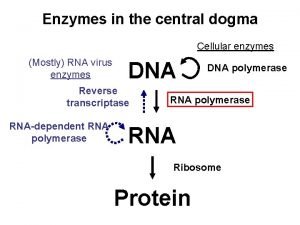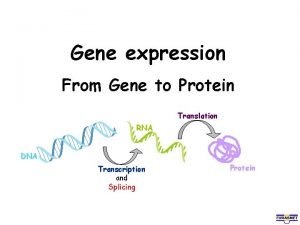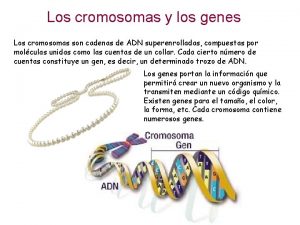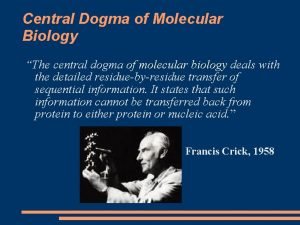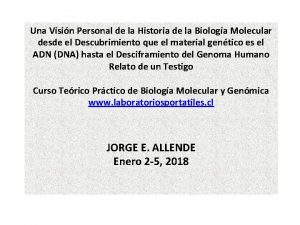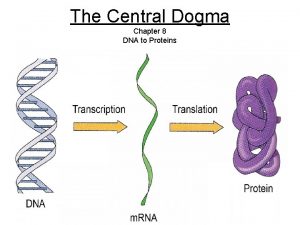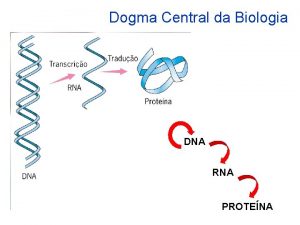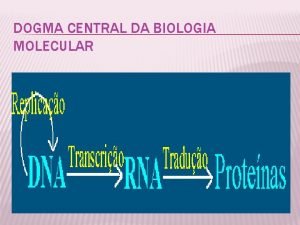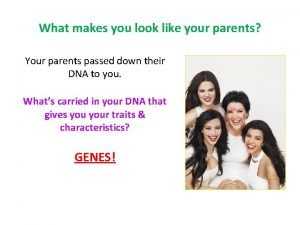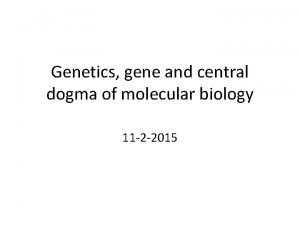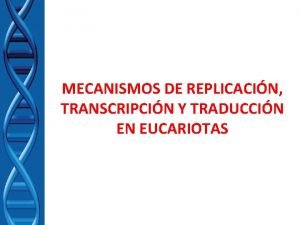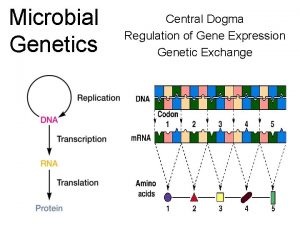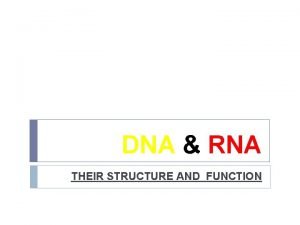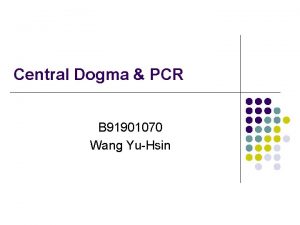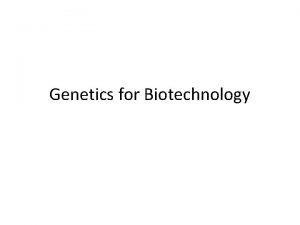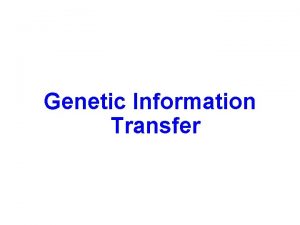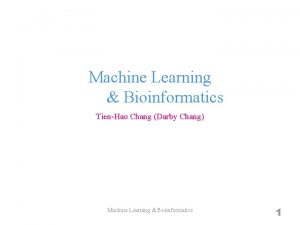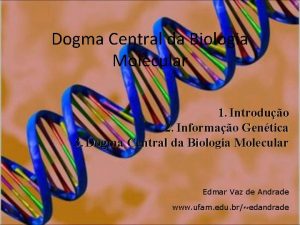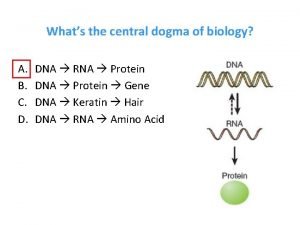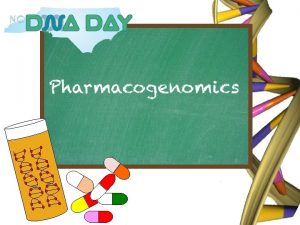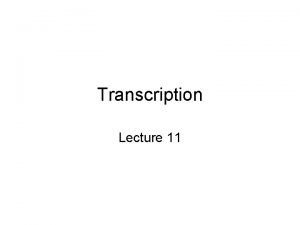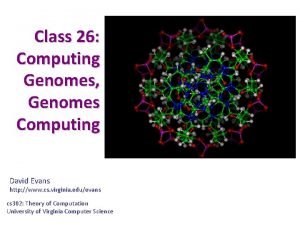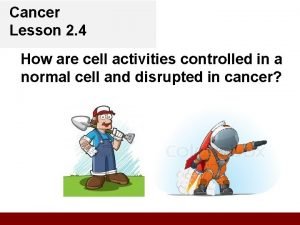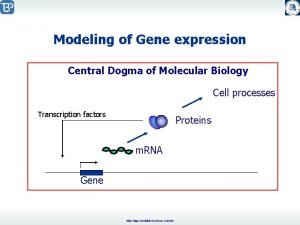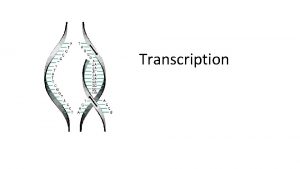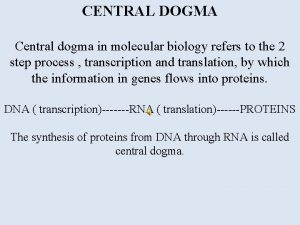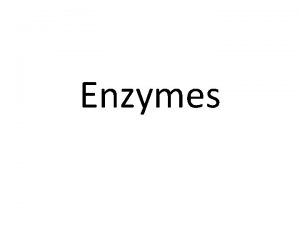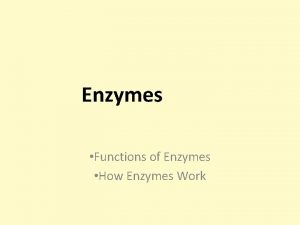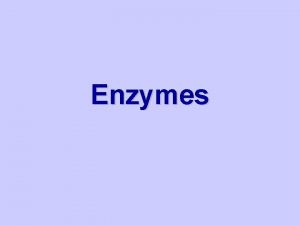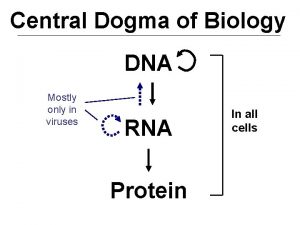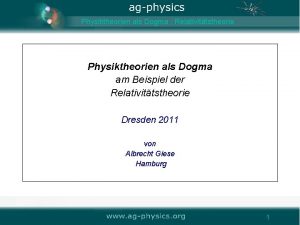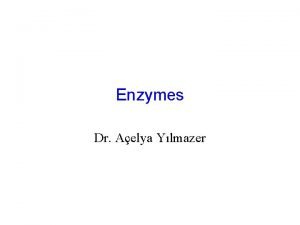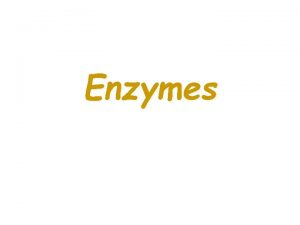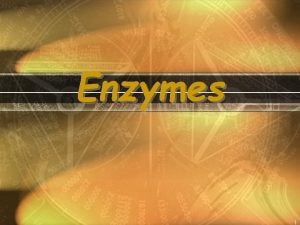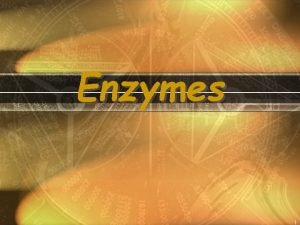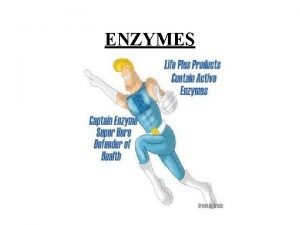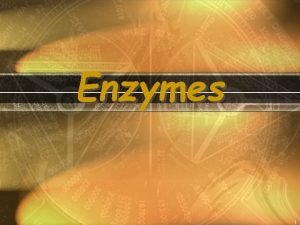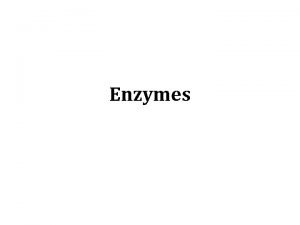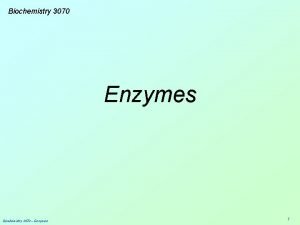Enzymes in the central dogma Cellular enzymes Mostly























- Slides: 23

Enzymes in the central dogma Cellular enzymes (Mostly) RNA virus enzymes DNA Reverse transcriptase RNA-dependent RNA polymerase DNA polymerase RNA Ribosome Protein

The process of transcription 3’ 5’ DNA template RNA 5’ 3’

The three steps of transcription: initiation, elongation and termination RNA polymerase Non-template strand DNA Template strand 5’ RNA 3’ 5’ Fig. 3. 14

E. coli promoter Fig. 6. 6

The following DNA contains a promoter. What is the sequence of the RNA made? 5’-AGTACTTGACATAGATGCGCGCTCGATGTATAATGCGCCACCAGAGTGATCG 3’-TCATGAACTGTATCTACGCGCGAGCTACATATTACGCGGTGGTCTCACTAGC -35 - Clicker A. 5’-OHUCUCACUAGCUppp-3’ B. 5’-ppp. UCUCACUAGCUOH-3’ C. 5’-p. AGAGUGAUCGAp-3’ D. 5’-ppp. AGAGUGAUCGAOH-3’ E. 5’-ppp. AGAGUGAUCGAp-3’ -10 Question -

E. coli RNA polymerase ‘ ‘ Holo-enzyme ( 2 ’ ) Core ( 2 ’) +

Sigma factor is needed for promoter binding ‘ ( 2 ’ ) ‘ Fig. 6. 3 ( 2 ’)

Experiment to test whether the RNA polymerase melts the region around the transcription start site DMS: Chemical that methylates unpaired As 32 P Nuclease Autorad Technique: see DNase/DMS footprinting (Weaver Ch. 5, p. 116 -119) Nuclease S 1: Nuclease that cleaves only single stranded DNA Fig. 6. 16

Evidence that the RNA polymerase melts the region around the transcription start site RNA polymerase: + + Nuclease S 1: - + + - Melted region Fig. 6. 17

In the shown experiment, the lane labeled R-S+ contains no RNA polymerase, but is still treated with Nuclease S 1. Why is this control experiment important? It tells you that: A. Nuclease S 1 cleaves ss. DNA. Clicker Question B. Nuclease S 1 does not- cleave the DNA when RNA polymerase was not there. C. RNA polymerase does not cleave ds. DNA. D. RNA polymerase is active in transcription. -

Evidence that the sigma subunit is reused Incorporation of 32 P-ATP/GTP ( 2 ’) 2) 1) Add holoenzyme ( 2 ’ ) Fig. 6. 11

Evidence that sigma stays bound during transcription elongation Fig. 6. 13 b Fig. 6. 14 b

The steps of transcription initiation in bacteria ? Fig. 6. 9

The alpha subunit of RNA polymerase can bind upstream (UP) elements in strong promoters Fig. 6. 26

Nucleotides cross-link to the RNA polymerase subunit SDS-PAGE/ autorad Fig. 6. 29 Fig. 6. 30

Both and ’ subunits interact with DNA during transcription ‘ * SDS-PAGE/ autorad cross-linker 32 P DNA Fig. 6. 33

Model of the transition from closed (RPc) to open (RPo) promoter complex ’ ’ Fig. 6. 43 a

An E. coli strain has acquired a lethal mutation in the promoter -10 box of an essential gene. Researchers subjected the strain to a mutagen, and selected a secondary mutation (i. e not in the same gene), which restored growth. Which of the following genes is most likely to carry the secondary mutation? A. RNA polymerase subunit. - Clicker Question - B. RNA polymerase subunit. C. RNA polymerase ’ subunit. D. RNA polymerase subunit. E. RNA polymerase e subunit.

You have isolated an antibiotic which kills E. coli cells by interacting with RNA polymerase. You discover that the antibiotic causes low production of ribosomal RNA but does not affect most m. RNAs. Which of the following RNA polymerase subunits is most likely to interact with the drug? - Clicker A. RNA polymerase subunit. B. RNA polymerase subunit. C. RNA polymerase ’ subunit. D. RNA polymerase subunit. E. RNA polymerase e subunit. Question -

Model for Rhoindependent (simple) transcription termination in bacteria RNA 3’end of simple terminator: 5’ UUUUUU 3’ Fig. 6. 46

Some terminators depend on the protein Rho DNA: RNA Heavy Free RNA Light Heavy Light DNA/RNA separated in Cs. Cl density gradients Fig. 6. 50

Model for Rhodependent transcription termination in bacteria Fig. 6. 51

Pa gene a Pb gene b Gene b is immediately downstream of gene a in E. coli and has its own promoter and a Rho-dependent terminator. An E. coli strain has acquired a mutation that causes the appearance of an RNA containing both genes a and b, but no sequence downstream of gene b. Clicker Question In which part of the genome is the mutation most likely to be? A. In the promoter for gene a. B. In the promoter for gene b. C. At the end of gene a. D. The RNA polymerase subunit gene. E. The Rho factor gene.
 Enzymes involved in central dogma
Enzymes involved in central dogma Central dogma of biology
Central dogma of biology Dogma central
Dogma central Whats the central dogma of biology
Whats the central dogma of biology Polirribosomas
Polirribosomas Central dogma
Central dogma Attcga
Attcga Dogma central
Dogma central Que es
Que es Dogma
Dogma Replicacion
Replicacion Central dogma cartoon
Central dogma cartoon Central dogma diagram
Central dogma diagram Central dogma
Central dogma Dna rna protein central dogma
Dna rna protein central dogma Replication
Replication Central dogma
Central dogma Dogma central da biologia
Dogma central da biologia Elongation
Elongation Drug metabolism liver
Drug metabolism liver Central dogma
Central dogma David evans chemistry
David evans chemistry Molecular dogma
Molecular dogma George boole
George boole
